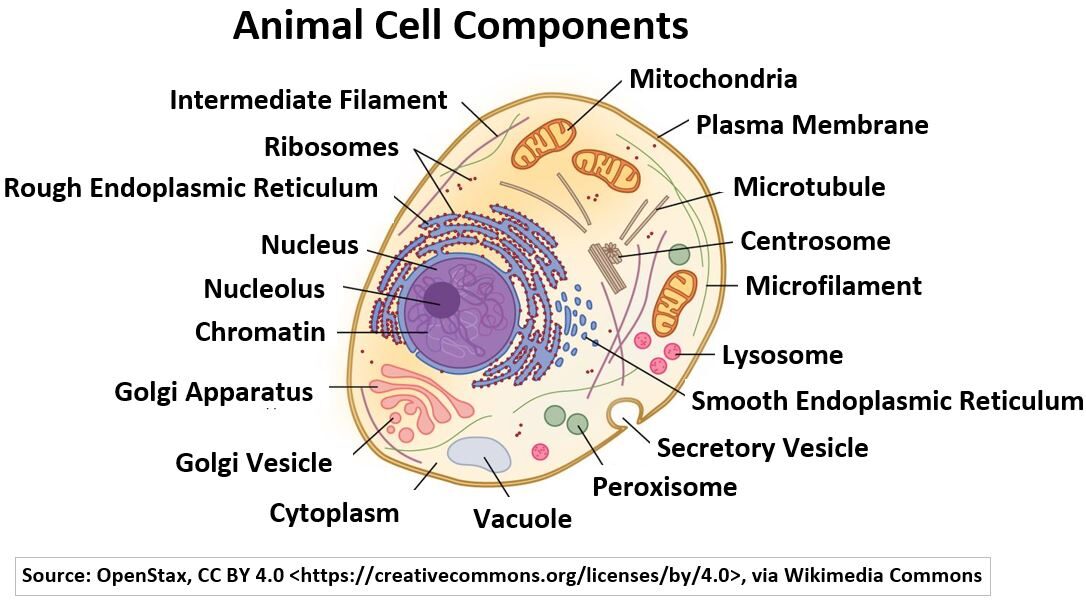Menu (linked Index)
Human Cell Components
Last Update: October 23/2024
Introduction
This post shows a picture of a typical human cell with its various membrane bound organelles or inner structures.
High level definitions are provided for these organelles.
In my opinion, the most efficient way to get a brief but useful onboarding to understanding human cell structure is to just watch the Sal Khan Video linked below:
Organelles in Eukaryotic cells – Khanacademy.org
The other recommended references listed in the reference section are pretty good as well.
Human Cell Components and Descriptions
Human cells are Eukaryotic, meaning they contain membrane bound “organelles”.
Examples of organelles would be the Nucleus (although not all cells contain Nuclei e.g. Red Blood Cells) and Mitochondria.
The picture below shows the typical components of a Human Cell.
Picture_Animal Cell Components

Click on the links below to learn more about the human cell and its components.
Internal Structures of Eukaryotic Cells
Cell
Organelle
“An organelle is a subcellular structure that has one or more specific jobs to perform in the cell, much like an organ does in the body. Among the more important cell organelles are the nuclei, which store genetic information; mitochondria, which produce chemical energy; and ribosomes, which assemble proteins.” Source
Ribosome
“A ribosome is the cellular machinery responsible for making proteins” Source
Mitochondria
“Mitochondria are membrane-bound cell organelles (mitochondrion, singular) that generate most of the chemical energy needed to power the cell’s biochemical reactions”. Source
Other sources:
“Cytoplasm is the gelatinous liquid that fills the inside of a cell. It is composed of water, salts, and various organic molecules.” Source
Lysosome
“A lysosome is a membrane-bound cell organelle that contains digestive enzymes. Lysosomes…break down excess or worn-out cell parts…..may be used to destroy invading viruses and bacteria.
If the cell is damaged beyond repair, lysosomes can help it to self-destruct in a process called programmed cell death, or apoptosis.” Source
Nucleus
“A nucleus…is the membrane-enclosed organelle within a cell that contains the chromosomes.
An array of holes, or pores, in the nuclear membrane allows for the selective passage of certain molecules (such as proteins and nucleic acids) into and out of the nucleus.” Source
Most human cells contain nuclei but not all (e.g. Red Blood Cells).
Smooth Endoplasmic Reticulum
“Endoplasmic reticulum is a network of membranes inside a cell through which proteins and other molecules move. Proteins are assembled at organelles called ribosomes.
- When proteins are destined to be part of the cell membrane or exported from the cell, the ribosomes assembling them attach to the endoplasmic reticulum, giving it a rough appearance.
- Smooth endoplasmic reticulum lacks ribosomes and helps synthesize and concentrate various substances needed by the cell.” Source
Rough Endoplasmic Reticulum
See Smooth Endoplasmic Reticulum
Golgi Body (Apparatus)
“A Golgi body, also known as a Golgi apparatus, is a cell organelle that helps process and package proteins and lipid molecules, especially proteins destined to be exported from the cell.
Named after its discoverer, Camillo Golgi, the Golgi body appears as a series of stacked membranes.” Source
Golgi body: Modifies, sorts, and packages proteins and other molecules.
Golgi vesicles: Small sacs that transport processed and packaged molecules to their final destinations.
Vacuole
“In animal cells, vacuoles are generally small and help sequester waste products.” Source
Peroxisome
“…Peroxisomes perform important functions, including lipid metabolism and chemical detoxification.
They also carry out oxidation reactions that break down fatty acids and amino acids.” Source
Centrosome
“A centrosome is a cellular structure involved in the process of cell division.
Before cell division, the centrosome duplicates and then, as division begins, the two centrosomes move to opposite ends of the cell.
Proteins called microtubules assemble into a spindle between the two centrosomes and help separate the replicated chromosomes into the daughter cells.” Source
Excellent Videos and Documents on Human Cell Structure
Disclaimer: The content of this article is intended for general informational and recreational purposes only and is not a substitute for professional “advice”. We are not responsible for your decisions and actions. Refer to our Disclaimer Page.
